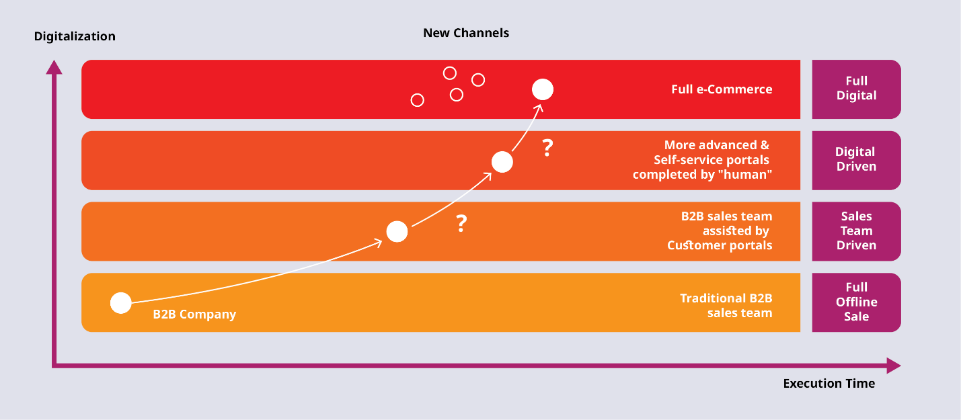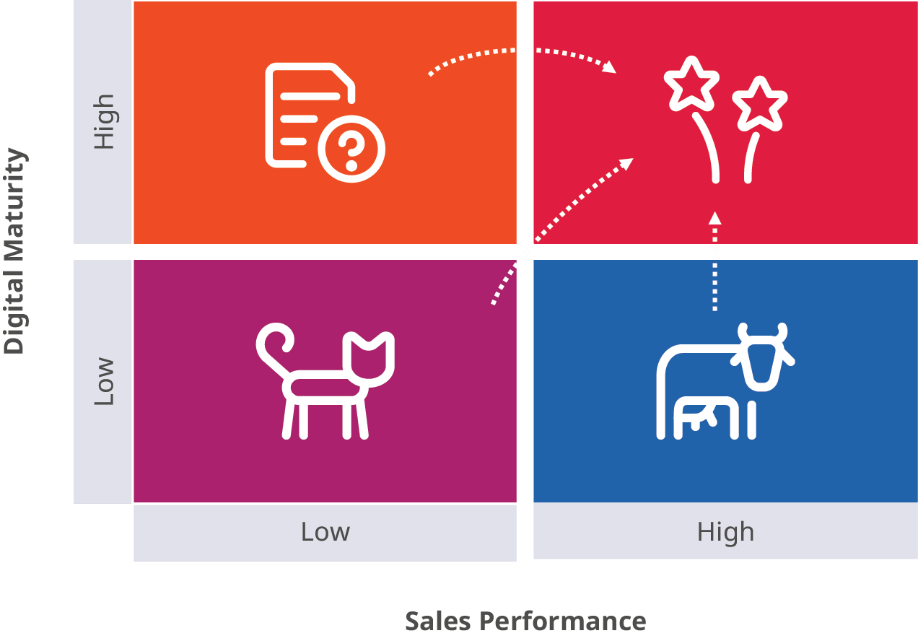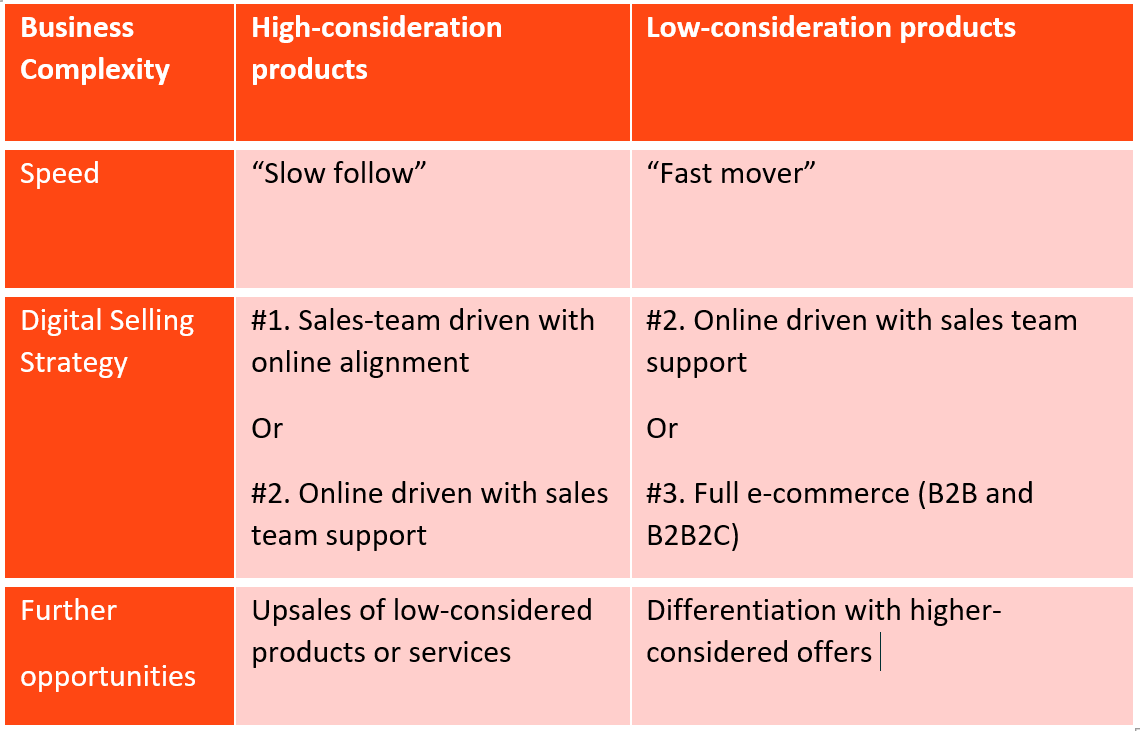Three B2B Strategies to Change Your Way of Selling part two

Transforming Existing Sales Channels – Key Considerations for Success
In part one of this two-blog series for leaders in B2B companies, I looked at the urgent (especially in the light of the Coronavirus pandemic) need for digital transformation by businesses who became complacent with their existing sales strategies and offered ways in which they can adopt different digital engagement models.
Figure 1. Three strategies to transform B2B Sales
Here, I shall discuss specific characteristics to consider and key questions that need to be asked to select and define the best approach to digital transformation: sales performance, digital maturity and business complexity.
There are important characteristics to consider and key questions need to be asked to select and define the best approach: sales performance, digital maturity and business complexity. The two first can easily be looked at in a variation of the well-known BCG Growth-Share matrix (below) – aiming at the top right hand quadrant where digital maturity and sales performance are high.
Figure 2. Growth-Share Matrix
Sales Performance
Just how well is Sales performing? How is the pipeline developing? These are probably the metrics that influence B2B leaders the most when it comes to transforming their ways of selling. If the sales team performs well, the sense of urgency to transform is weaker and may delay this move or at the very least, push digital selling down to a lower place on the management priority list. But, with Coronavirus sweeping every economy, it’s no time to be resting on your laurels.
The evolution of the pipeline as well as customer feedback are additional signals in monitoring and assessing how critical and how fast change should happen. If sales performance is dropping, the importance of finding new ways to engage buyers is obviously higher and B2B companies should act faster and see Strategies 2 or 3 (online driven with sales team support or full e-commerce) as a potential differentiator.
It is also important to mention that these changes are heavily affected by a company’s digital maturity.
Digital Maturity
As it became evident that Digital Transformation is much more than a simple buzzword, indeed, a business opportunity and a necessity that is incredibly complex to reach, it is also clear that not all companies are equal in terms of chances of succeeding .
That’s where the concept of “Digital Maturity” comes from, as a way to measure how ready companies and organizations are to engage in a digital transformation program.
Digital Maturity helps assess whether, and how fast, an organization can adapt and thrive or stagnate and decline in our ever-evolving digital landscape. It should not be seen as a static measurement, it is a gradual process that an organization can work on to progress over time, just as children don’t grow up overnight but go through stages – from toddler to child, through adolescence into adults – digital maturity helps us understand the different stages an organization can go through to master digital, knowing that the process is never complete.
Most main consulting and research companies have created maturity models and frameworks [1] to help companies engage in such a process. It can also be approached with common sense and simpler methodologies too. Whatever approach you take, it is clear that it is much more than purely about technology, it is about organization, about culture as well as being about resistance or acceptance to change and disruption.
Business Complexity
The speed of transformation is often related to the complexity of the business. Complexity in terms of production (supply chain integration, logistics, stocks, delivery); in terms of sophistication requiring advisory interaction in the sales process; and in terms of pricing since highly-priced products are considered less e-commerce friendly. The specifics of any B2B company impact the level of investment required to fully, or partly, automate digital selling.
In general, the least complex, the faster a B2B company should be able to transform their traditional sales channels. In the case of complex B2B products and processes, agility and a progressive approach matter even more since an all-in-one transformation is almost impossible. Forrester anticipated that B2B business with “inherent complexity” would need to keep their B2B Salesmen longer (while over-estimating the move to online shops and self-service). On this topic, Forrester confirmed last year that there is a lot more to do when it comes to selling complex products online: “Many B2B digital business pros have focused their digital efforts on B2B e-commerce for low-consideration purchases and have yet to broaden their digital horizon to better support more complex, assisted purchases.”
Indeed, expensive purchases with negotiations, advanced installations or servicing can hardly be completely automated. In these use cases, buyers will value the interaction with salespeople and implementing full e-commerce (Strategy 3) is almost utopian. Aiming to advanced customer portals with sales assistance seems to make more sense (Strategy 2).
It is also interesting to mention the digital opportunities for B2B sellers to either upsell with lower-considered products or services (parts, maintenance services, insurance) or to differentiate for more commoditized product vendors by moving upmarket, offering more sophisticated sales-assisted offers with higher margins.
Figure 3. Considerations for which Strategy to adopt
Diversifying Sales
Independently from the selected strategy, customer and dealer portals or complete shops require a smart mix of content, branding, and applications to better engage audiences in a personalized way all along their journey. Digitalizing current sales channels is no longer sufficient, buyers are diversifying their ways of buying.
If you want to identify which transformation path makes the most sense of your business, then contact us to discuss and explore which is right for you.
[1] If you want to delve deeper into understanding Digital Maturity, you may want to look at the BCG’s Digital Acceleration Index; publications from Deloitte around the seven pivots towards digital maturity; or the research from the analyst, Forrester, around what digital maturity and digital excellence looks like.
Businesses need DXPs to respond to change, and to invent the disruption of tomorrow
The Three Pillars of Successful B2B Digital Transformation
B2Bs have to be bold and inventive to disrupt their own business models, read how to be successful in our eBook. If you are struggling with your B2B digital transformation efforts, why not reach out to us to discuss your project.




